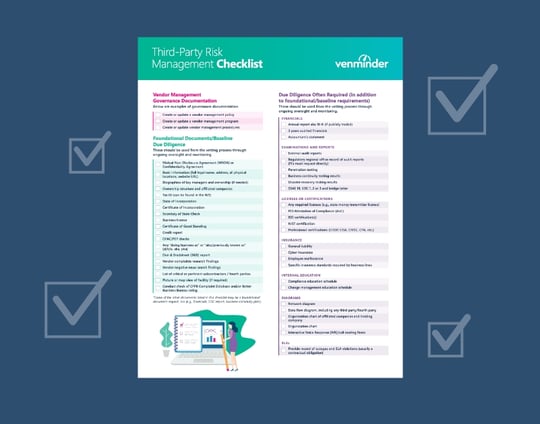Many industries utilize a vendor management model called “The Three Lines of Defense.” This model is designed to clarify the various roles and responsibilities involved in vendor risk management for senior leadership and the board.
This blog will explore how the first line can be leveraged and optimized for effective vendor management. But first, let's dive into the three lines of defense.
The three lines of defense model splits responsibility for vendor risk into the following:
- The first line: Those who own and manage vendor risk management are the first line. Usually, the first line references the actual lines of business or departments, divisions or teams and the vendor owners that sit within those organizations.
- The second line: Those that oversee vendor risks fall into the second line. This generally includes the vendor risk team, enterprise risk team, compliance, legal, finance and information security.
- The third line: Those functions that provide independent assurance over risks and monitor the effectiveness of risk management activities, i.e., internal audit, are referred to as the third line.
Now that we understand the three lines of defense, let's examine how to use the first line of defense for optimal vendor risk management.

4 Reasons Why You Should Use the First Line of Defense
- Knowledge around daily vendor matters and details: The business unit (product manager, vendor owner or the like) is responsible for the product or service that the vendor is providing. They should understand it much better than others in the organization. And their regular interactions with the vendor positions them to know if everything is working as expected or if trouble is brewing. The first line should also have a fine-tuned understanding of industry norms and other business nuances that aren’t always obvious to less experienced collaborators. When in doubt, the first line should always be on point to articulate and explain vendor issues or make requests internally on behalf of their vendor.
- Essential collaboration: To be effective, vendor risk management teams (the second line) must embrace a level of independence from vendor relationships. Still, situations often require the vendor owner (the first line) to facilitate collaboration between a vendor and other internal stakeholders such as vendor risk management or subject matter experts (the second line), especially when remediating complex issues. The vendor owner's day-to-day relationship with their vendors lets them translate internal requests back to the vendor and helps them navigate questions or concerns.
- Relationship leverage: Occasionally, some vendors will choose to ignore requests coming to them directly from vendor risk management, procurement or other internal stakeholders. After repeated requests, it sometimes becomes necessary to involve the vendor owner to make a point. More simply put, a reticent vendor is more likely to respond to requests made by those with the power to approve an invoice or to renew (or not renew) the contract.
- Feedback that drives action: As an internal customer of the vendor risk management process, the first line must have a seat at the table. Since the first line can significantly add to or detract from the success of your vendor risk management program, their feedback should be encouraged often and incorporated when practical. If your first line becomes the proverbial squeaky wheel, try and be more generous with the "oil." When the first line provides information knowing that it’ll be utilized, you’ll both be much happier and more productive in the end.
Inefficient Ways to Utilize the First Line
Using the first line of defense in vendor risk management can be beneficial if you take the proper approach. Alternatively, the following methods may result in inefficiencies:
- Sole reliance: Resting the entire burden of vendor risk management on the shoulders of the first line isn’t only unfair, but it's also downright ineffective. While the first line plays a crucial role in vendor risk management, other stakeholders must fulfill their respective third-party risk management duties. A strong vendor management team ensures that respective stakeholders play to their strengths and all lines of defense to engage how and when they are supposed to.
- Out of scope expectations: The first line of defense has many business objectives and managing vendors is only a portion of their daily responsibility. When it comes to due diligence, it’s unrealistic and impractical to expect them to be subject matter experts or provide qualified opinions on vendor risk management controls. Vendor risk management should ensure that job is left to subject matter experts specializing in vendor risk assessments.
- Disorganized and duplicate requests: The vendor risk management team must ensure the processes are straightforward and easy to follow and that the first line isn’t expected to submit the same information or answer the same question multiple times. This includes asking for data across multiple forms or systems. Effective vendor management processes are efficient and are designed to make the best use of everyone's time.
When it comes to the first line, a solid and respectful relationship with the second line is imperative. Vendor risk managers need to proactively reach across the siloes to ensure the first line feels engaged and supported.

7 Great Tips to Leverage the First Line of Defense
Keep these tips in mind to ensure that you’re optimizing the capabilities of the first line of defense:
- Be inclusive. Meet with the first line regularly and provide a process where feedback may be submitted. Engage your first line with sincerity and respect as you would any customer.
- Offer regular recurring education. Provide the first line the opportunity for education on third-party risk and other compliance requirements. This can help front-line managers understand their vital role in the vendor risk management process
- Maintain communication. The first line can be a vital tool to communicate directly with the vendor, get questions answered, collect documents and tie up loose ends.
- Ask the right questions. Ask your first line what their pain points are. Investing in your first line of defense and offering support and guidance can foster greater collaboration.
- Manage complaints. These should be escalated, addressed and logged for future discussion. Since complaints are often made at the transaction level, there’s a risk that the first line will move on after it’s resolved.
- Set expectations. This may seem like a standard best practice, but you may be surprised that the term "First Line of Defense" means very little at the practical level for a business user. Ultimately, everyone in an organization is a risk manager. Communicating the importance of this aspect of their day-to-day duties will help strengthen your organization's overall approach and support your culture of compliance and risk.
- Utilize their product/service expertise. If your vendor risk management department doesn't know much about a specific product or service, partner with the first line to learn more. When you invest in understanding the business, you can be a better facilitator and a trusted partner. Understanding how a product is used by the business can go a long way in understanding the opportunities available and associated risks.
As the day-to-day owners of your vendor relationships, your first line plays a valuable part in effective vendor risk management. When the second line makes an effort to ensure the first line feels engaged, supported and respected, vendor risk management practices are enhanced and the whole organization benefits



















